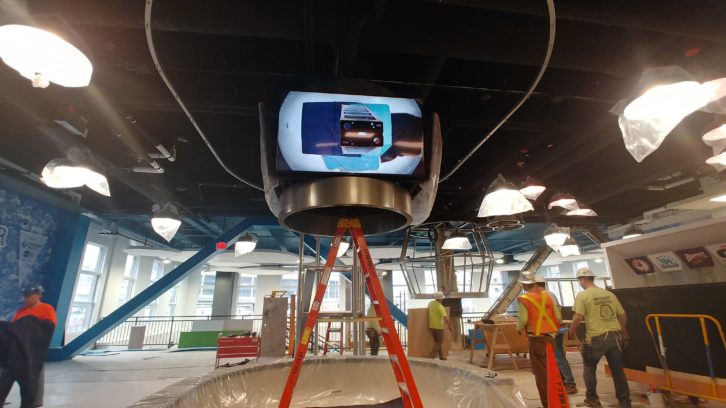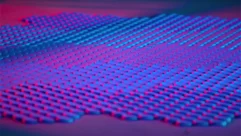Photos by Christy Francis
 On this edition of the SVC Podcast, Contributing Editor Bennett Liles concludes his conversation with Heather Sidorowicz of Southtown AV about the new Explore and More children’s museum in Buffalo, New York. Heather details the installation of cameras in the museum’s play spaces and she outlines the AV control and sound isolation techniques used for the AV installation project.
On this edition of the SVC Podcast, Contributing Editor Bennett Liles concludes his conversation with Heather Sidorowicz of Southtown AV about the new Explore and More children’s museum in Buffalo, New York. Heather details the installation of cameras in the museum’s play spaces and she outlines the AV control and sound isolation techniques used for the AV installation project.
FOR MORE: GO TO PART 1
- Southtown AV (SAV) in Hamburg, New York
- BrightSign digital signage systems
- Crestron CP3N 3-Series control system
- Personal tour of D-Tools System Integrator software
- Marshall CV502-M 3GSDI cameras
TRANSCRIPT:
At the new Explore & More Children’s Museum in Buffalo, New York the exhibits come alive in the hands of the visiting kids. Setting up the AV design and installation was a tall task handled by local AV integrator Southtown Audio Video. Heather Sidorowicz is back to finish her story on how they got it all to work. That’s coming right up on the SVC Podcast.
Heather, thank you for being back with us on the SVC Podcast from Southtown Audio Video in Hamburg, New York and we were talking about the Ralph C. Wilson, Jr. Children’s Museum, Explore & More in Buffalo. The incredible job that you did on getting the kids immersed in the technology there, maintaining their attention span in a museum where they can really do hands-on things. We mentioned cameras last time. What type of cameras did you put in there?
So what we used is cameras by Marshall. And the reason we used them is they were a very small format camera. So we didn’t want something that was going to be an eyesore to take away from anything else. So these are very small cameras. They’re 2.5 megapixel, HD, 3G SDI Marshall cameras. Then, of course, we had to get specific lenses to make that work. [Timestamp: 1:20]
And one of the images that have from this shows some Brightsign HD players mounted on a wall. It looks like they are located out of the way sort of behind the scenes.
That one specifically, that is actually underneath kind of in this hidden room of the canal boat that we spoke about last time. The canal boat launches many different audio commands from a cupboard that the kids can open that tells a story to a rudder that’s attached to the boat that says Port or Starboard. So there’s multiple different Brightsign players to be able to launch those commands. And also in another spot, actually, behind those TVs in what we called the Jumbotron, that’s also run by Brightsign. [Timestamp: 2:01]
OK, I think there are some Atlona components in there, too.
Yeah. I believe the Atlona in the one that we’re talking about was just to extend audio to allow us to do that over data cable [Timestamp: 2:12]

That building is a big place. You mentioned that it has four floors and lots of exhibits. How are the AV systems, the lights, displays and everything, controlled? Are they all controlled from a central location?
They are all on an overall simple control system by Crestron. And that system will turn the exhibits on and off daily at a scheduled time, but does also allow the exhibit to override that schedule so that they can reboot if they needed to or keep an exhibit on longer than the scheduled day if they’re going to have any after-hours events. [Timestamp: 2:51]
Some of that Crestron programming is more advanced but it’s also much more flexible than you can do with some other systems.
We needed an open template and a very good Crestron programmer, which we luckily have to be able to do such things. [Timestamp: 3:03]
OK and that was your preference, the Crestron for price, features and experience with it?
Yeah, and it just works forever. I mean, we had a client that we did, my goodness, maybe back in 2008. And we were sure the client must have upgraded their system and gone to a different system by now because we hadn’t heard back from them. And we just hadn’t heard that they hadn’t complained about any issues. No, lo and behold the system was just still working. And that’s really what you get with Crestron. When it works, it works forever. [Timestamp: 3:32]
Well, that’s the old “no news is good news” type of thing for AV people.
Not because the system broke, but they ended up upgrading because they wanted some new features. [Timestamp: 3:41]
And we sort of touched on this earlier but did you run into anything unexpected or have to change some plans during the project? I think there were some revisions.
Absolutely. Absolutely we did, right? In a project like this I don’t think you could ever expect we’d get beginning to end without revisions. So the cameras that we talked about earlier, the original lens that we had ordered was not the lens that we ended up having to use because the client changed the location. So you can easily create a revision to do that. And through great relationships with manufacturers some of the stuff we were able to send back or able to keep. So yeah, there were definitely revisions and again I think through good communication and being able to track that, I mean that could be a fatal flaw especially in a project so large and complicated that if you can’t track those revisions and pricing you’re going to lose money instead of make money and nobody wants to do that. [Timestamp: 4:37]

Once the kids get in there they have plenty of visuals to see. They can see themselves on the displays but only if they look straight at them. For the sound it’s different and there would probably have to be some arrangement to control sound isolation.
Different exhibits have unique ways to hide the speakers or to just kind of have them available in that one area. And because of the spacing of the exhibits there really wasn’t an issue that one exhibit was overtaking another, which was great. And I think that has a lot to do with the way the overall system was designed by the exhibit company and by the client. None of them are on top of each other so it’s really a nice design. [Timestamp: 5:15]
Of course, getting it all in there and connected is one thing but then you have to test it and then demonstrate it to the kids. So what was their reaction? Did you have to make any changes once they got in there and experienced it?
Yes. We had to maintain the system for the first year, but we had planned on that so that was all built in. But actually before I mention anything with the kids I have to tell you that what we had talked with the client about is that we would be there for their first large event. And so before the museum actually opened to the public they had a donor party. So this was an after-hours for people who had committed funding to get the exhibit off the ground. To be there that evening and to almost be “working the event” in conjunction with the client, and to hear the giggles, the laughter from the grownups, that was amazing. I mean, that was probably my favorite moment on the project because for me, I had seen this for three years at that point. To see it not just installed, but to see that grownups were having such an immersive, fun experience, I don’t think that that can be beat. Of course as the kids came in later on they also absolutely loved it. The client had a contractor day so they invited anyone that had worked on the building and their children. That was a great experience, to not go just myself and my kids but with my staff and their children. It was a team-building experience for sure but also for them to be so proud of something that they’d worked on, and for their families to see what they’d been up to. [Timestamp: 6:46]
Well, you would think that the kids would want to get more involved with it after they see their parents being amused and they don’t want to be left out of the action.
Yeah. And the day that we went, the youngest was a baby, like less than two, and the oldest was 13. I think there were over six children the day that we went that just in our group of the company and there wasn’t one single child that wasn’t amused by one exhibit or the other. They all laughed enjoying themselves and wanting to go back. And I think that that speaks volumes for the way that the whole system was put together. [Timestamp: 7:18]
That’s great when you can put all the AV stuff in and keep it behind the scenes and have it working and be completely transparent.
Agreed. Yes.
And now that this one is in the books and you’ve got this experience, what do you have coming up next at Southtown Audio Video?
Well, we continue to work on our different jobs which involve corporate education and healthcare. I have a quote in front of me right now that I have to send pricing over by next week for another museum. And we’ll just keep on keeping on, so we’ll continue to look for interesting projects. We like to work with clients that understand that relationship and know that what we’re installing is the right equipment for the job, that lasts not just today but tomorrow and down the road. Yeah, so we’re thrilled to continue down these markets. [Timestamp: 8:05]
Well, I’m sure that you’re going to able to rely on some of the experience here and apply some of the things you learned on this to some of these future projects.
Absolutely.
It’s been fun hearing about this, a very unusual place. I don’t think we’ve done any stories on AV in a children’s museum but I feel sure that the idea will catch on. We’ve been talking about the Ralph C. Wilson, Jr. Children’s Museum in Buffalo. Explore & More gets the kids in there with engaging hands-on exhibits. Great talking with Heather Sidorowicz of Southtown Audio Video in Hamburg, New York. Congratulations on a great success.
Thank you, Bennett. It’s been a pleasure.
Getting all of the AV to work in the new Explore & More children’s museum was a challenge successfully handled by Southtown Audio Video. Thanks to Heather for giving us all the details. Next week we’ll have another AV installation case study so get back with us for the next SVC Podcast.










